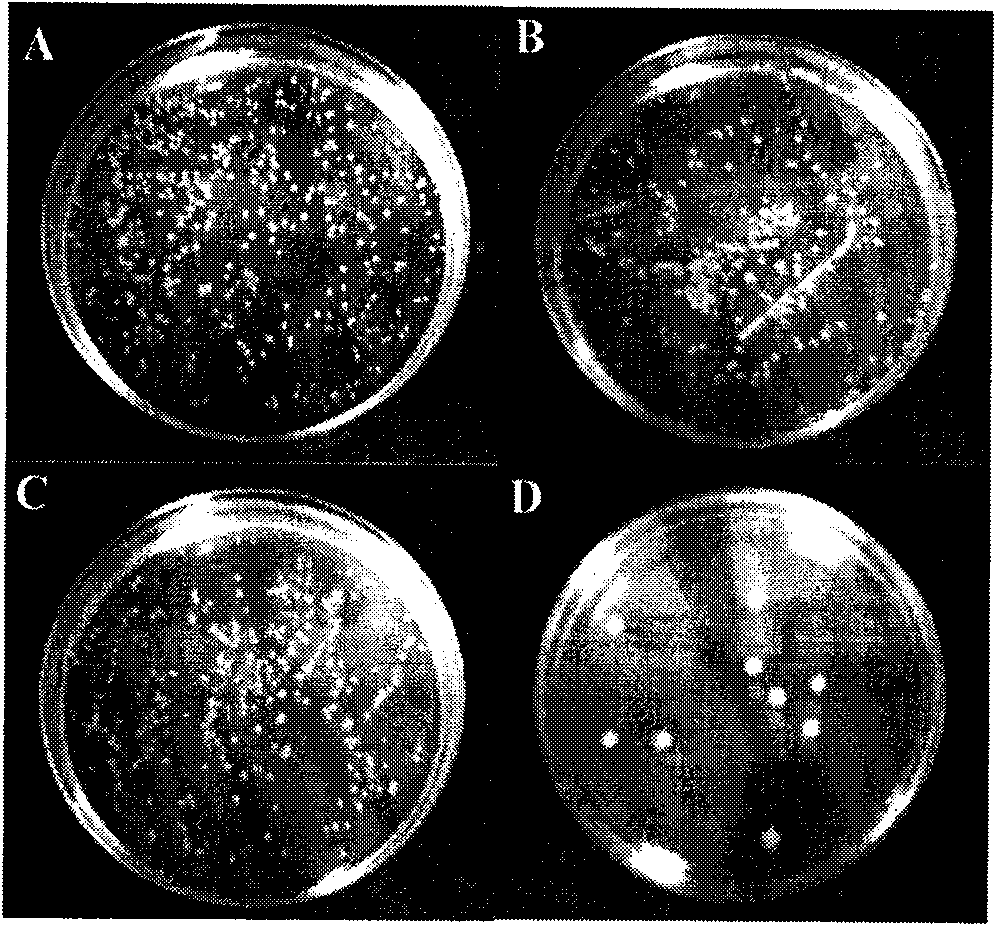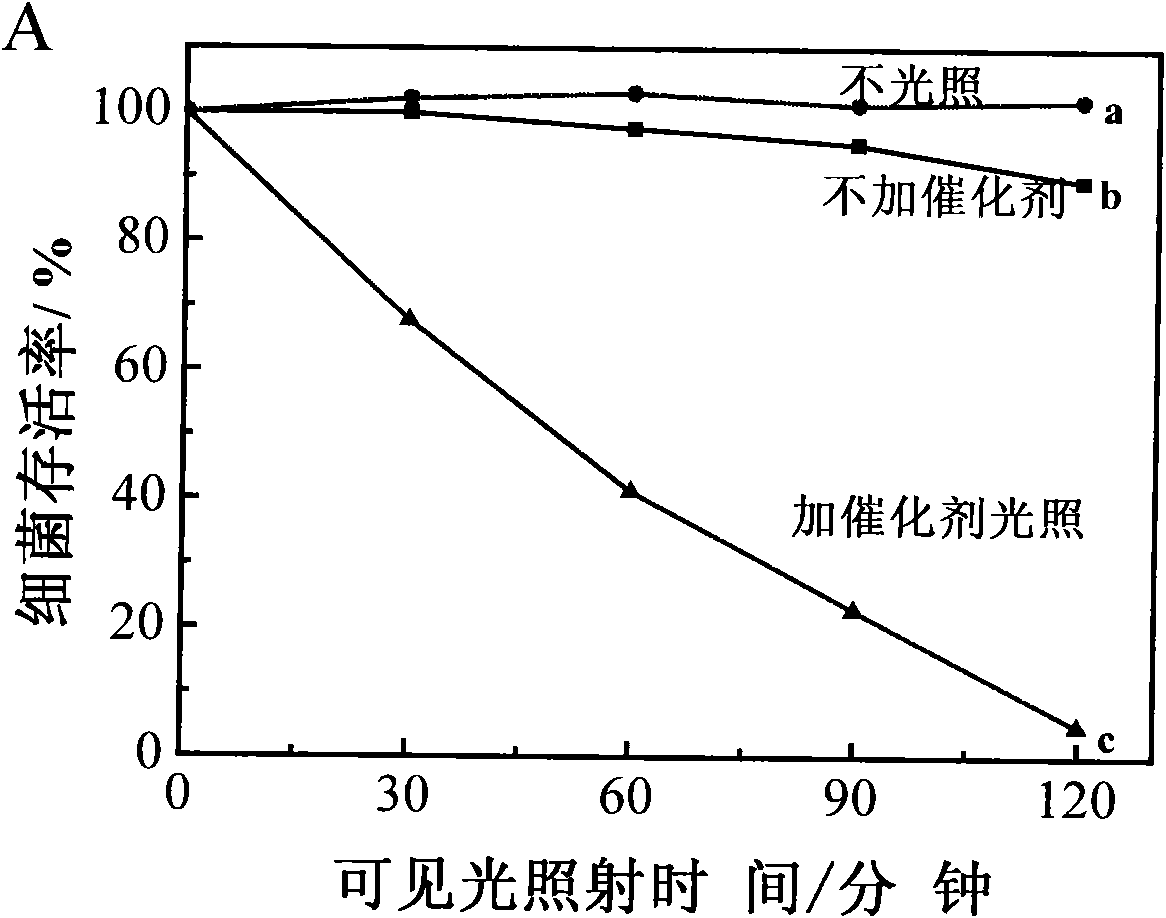Photocatalysis antibacterial material excited by visible light and application thereof
A photocatalytic material and visible light technology, applied in the direction of application, catalyst activation/preparation, physical/chemical process catalyst, etc., to achieve the effect of overcoming limitations, good photocatalytic antibacterial activity, and improving utilization rate
- Summary
- Abstract
- Description
- Claims
- Application Information
AI Technical Summary
Problems solved by technology
Method used
Image
Examples
Embodiment 1
[0023] Embodiment 1 Pure Bi 2 WO 6 Preparation of and its application in the detection of photocatalytic antibacterial activity
[0024] Bi 2 WO 6 Using Bi(NO 3 ) 2 ·5H 2 O and Na 2 WO 4 2H 2 O is synthesized as a raw material, and according to the stoichiometric ratio, weigh 0.97g Bi(NO 3 ) 2 ·5H 2 O (analytically pure) was dissolved in 20mL of water, then 0.210g of citric acid was added, stirred for 30 minutes, and 0.329g of Na 2 WO 4 2H 2 O (analytical grade) was dissolved in 20 mL of water, and the two were mixed and stirred to form a white suspension precursor. Then take a certain volume and put it into a hydrothermal kettle, and treat it at a temperature of 180° C. for 24 hours. After the reaction, the obtained pale yellow precipitate was filtered, washed with deionized water and absolute ethanol five times each, and then dried at 80°C. Such as figure 1 , determined to be Bi by XRD phase analysis 2 WO 6 , through the determination of the UV / Vis diffuse...
Embodiment 2
[0026] Example 2 Different amounts of Ag ion-supported Bi 2 WO 6 Preparation of materials and their application in photocatalytic antibacterial detection
[0027] a) The whole system is an ethanol system, and 0.01M Bi(NO 3 ) 2 ·5H 2 O (analytical grade) and 0.01M Na 2 WO 4 2H 2 O (analytical pure) was stirred evenly, and 0.0025M AgNO was added3 , and stir for 10 minutes to mix well. Then take a certain volume of the precursor and put it into a hydrothermal kettle, and treat it at a temperature of 160°C for 24 hours. After the reaction, the obtained precipitate was filtered, washed with deionized water and absolute ethanol five times each, and then dried at 60°C. Such as Figure 4 , due to the small amount of Ag, the characteristic peak of Ag cannot be clearly seen (AB-0.1) in the XRD spectrum, but in the UV / Visible diffuse reflectance spectrum, the bulging due to the surface plasmon resonance absorption of Ag can be seen ( Figure 5 ), and the peak of Ag can be seen ...
Embodiment 3
[0031] The Bi of embodiment 3Ni ion loading 2 WO 6 Preparation of materials and their application in photocatalytic antibacterial detection
[0032] The whole system is an ethylene glycol system, and 0.05M Bi(NO 3 ) 2 ·5H 2 O (analytical grade) and 0.05M Na 2 WO 4 2H 2 O (analytical pure) was stirred evenly, and 0.005M Ni(NO 3 ) 2 ·6H 2 O, stir for 10 minutes, mix well. Then take a certain volume of the precursor and put it into a hydrothermal kettle, and treat it at a temperature of 160°C for 24 hours. After the reaction, the obtained precipitate was filtered, washed with deionized water and absolute ethanol five times each, and then dried at 60°C. The product was identified as Ni / Bi by XRD and energy spectrum composition analysis 2 WO 6 , Ni loading Bi 2 WO 6 The photocatalytic antibacterial performance is greatly improved. After 30 minutes of light, the antibacterial rate reaches 99%. All the other are with embodiment 2.
PUM
 Login to View More
Login to View More Abstract
Description
Claims
Application Information
 Login to View More
Login to View More - R&D
- Intellectual Property
- Life Sciences
- Materials
- Tech Scout
- Unparalleled Data Quality
- Higher Quality Content
- 60% Fewer Hallucinations
Browse by: Latest US Patents, China's latest patents, Technical Efficacy Thesaurus, Application Domain, Technology Topic, Popular Technical Reports.
© 2025 PatSnap. All rights reserved.Legal|Privacy policy|Modern Slavery Act Transparency Statement|Sitemap|About US| Contact US: help@patsnap.com



